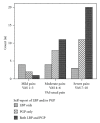Pregnancy-related lumbopelvic pain: listening to Australian women
- PMID: 22685643
- PMCID: PMC3366229
- DOI: 10.1155/2012/387428
Pregnancy-related lumbopelvic pain: listening to Australian women
Abstract
Objective. To investigate the prevalence and nature of lumbo-pelvic pain (LPP), that is experienced by women in the lumbar and/or sacro-iliac area and/or symphysis pubis during pregnancy. Design. Cross-sectional, descriptive study. Setting. An Australian public hospital antenatal clinic.
Sample population: Women in their third trimester of pregnancy. Method. Women were recruited to the study as they presented for their antenatal appointment. A survey collected demographic data and was used to self report LPP. A pain diagram differentiated low back, pelvic girdle or combined pain. Closed and open ended questions explored the experiences of the women. Main Outcome Measures. The Visual Analogue Scale and the Oswestry Disability Index (Version 2.1a). Results. There was a high prevalence of self reported LPP during the pregnancy (71%). An association was found between the reporting of LPP, multiparity, and a previous history of LPP. The mean intensity score for usual pain was 6/10 and four out of five women reported disability associated with the condition. Most women (71%) had reported their symptoms to their maternity carer however only a small proportion of these women received intervention. Conclusion. LPP is a potentially significant health issue during pregnancy.
Figures







References
-
- Grigg C. Working with women in pregnancy. In: Pairman S, Pincombe J, Thorogood C, Tracey S, editors. Midwifery: Preparation for Practice. Sydney, Australia: Elsevier Churchill Livingstone; 2006.
-
- Yerby M. Minor disorders of pregnancy. In: Stables D, Rankin J, editors. Physiology in the Childbearing Year: with Anatomy and Related Biosciences. Edinburgh, UK: Elsevier; 2005.
-
- Enkin M, Keirse M, Neilson J, et al. A Guide to Effective Care in Pregnancy and Childbirth . Oxford University Press; 2000.
-
- Mogren IM. Perceived health, sick leave, psychosocial situation, and sexual life in women with low-back pain and pelvic pain during pregnancy. Acta Obstetricia et Gynecologica Scandinavica. 2006;85:647–656. - PubMed
-
- Babarinsa IA, Adewole IF, Fatade AO, Ajayi AB. Obstetric pubic symphysis arthropathy: a study of nine cases. Journal of Obstetrics and Gynaecology. 1999;19(6):620–622. - PubMed
LinkOut - more resources
Full Text Sources

